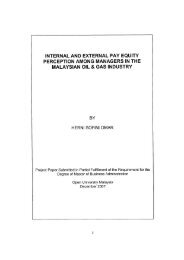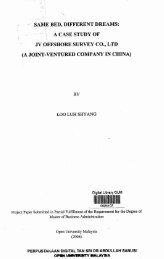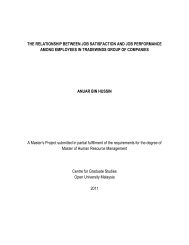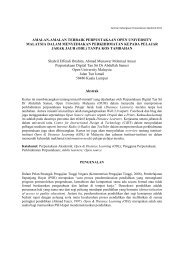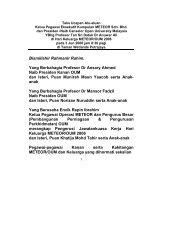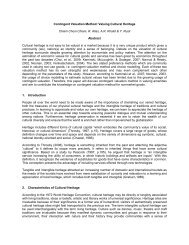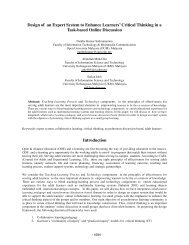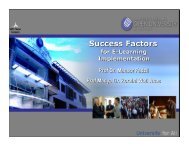Title of paper: - OUM i-Repository - Open University Malaysia
Title of paper: - OUM i-Repository - Open University Malaysia
Title of paper: - OUM i-Repository - Open University Malaysia
- No tags were found...
Create successful ePaper yourself
Turn your PDF publications into a flip-book with our unique Google optimized e-Paper software.
ICI9 - International Conference on Information; Kuala Lumpur, 12 – 13 August 2009Online Learning,12%Face-to-FaceTutorials, 8%Self-ManagedLearning, 80%Figure 1: Proportion <strong>of</strong> <strong>OUM</strong> Learning ModesSource: <strong>Open</strong> <strong>University</strong> <strong>Malaysia</strong> (<strong>OUM</strong>) Tutor’s Handbook (2008)The university utilises the combination <strong>of</strong> printed learning materials as the main learning resourcesupplemented by face-to-face interactions at learning centres and online learning through a designedLearning Management System (myLMS). MyLMS’s essential feature is the asynchronous forumboard that includes a series <strong>of</strong> functions such as forum, announcements, course material and courseoutline as well as online registration. Othman et al. (2005) argued that although the interactiveelement in the asynchronous forum board <strong>of</strong> the <strong>OUM</strong> has successfully created a positive learningenvironment through the high level communicative exchanges and instructional purposes, it appearsthat the interactions observed in their study lack the desired depth imperative for a rich and activecollaborative environment that creates meaningful learning experiences among learners as well as thepreferable cognitive dimensions necessary for high levels understanding and knowledge construction.With the current web-based teaching and learning system, <strong>OUM</strong> learners are able to gain access to anunprecedented wealth <strong>of</strong> multimedia information including course materials, examination materials,library databases <strong>of</strong> e-books, e-journals and other library collections as well as the ability to interactasynchronously, outside face-to-face tutorials with peers and tutors using myLMS. <strong>OUM</strong> learners areprovided with a wealth <strong>of</strong> various learning objects, many <strong>of</strong> which are assessable via myLMS learningmanagement system. There are however other learning objects and learning materials that areavailable but “scattered”. Some <strong>of</strong> these learning objects are learning materials on CD, learningcourseware, printed modules and mobile learning system.As the bulk <strong>of</strong> the learners’ study time is spent on self-managed learning (as illustrated in Figure 1),there must be a transition from tutor-centred to learner-centred approach with a renewed emphasis onlearning-oriented instruction and interactive learning. However, in providing quality support tolearners particularly the adult learners, ODL institutions need to understand the expectations <strong>of</strong> itslearners. Based on the existing mix <strong>of</strong> delivery mode and integrated learning model <strong>of</strong> ODL, there areissues that need to be addressed in order to move the learning process forward.Current Learning Model <strong>of</strong> <strong>OUM</strong>The use <strong>of</strong> innovative technology has enhanced education delivery and knowledge acquisition in theODL environment. Web-based environment and various learning objects have been developed andused at <strong>OUM</strong> to support various learning scenarios. Figure 2 describes the current learning model <strong>of</strong><strong>OUM</strong>.180
ICI9 - International Conference on Information; Kuala Lumpur, 12 – 13 August 2009i-RadioMultimedialearninge-mailDigitalLibraryMyLMSThe LearnerDigital OnlineLibrar ForumDigitalNotesMobileLearningAssessmentLearningMaterialson CDPrintedModuleFace-to-FaceFigure 2: Current Learning Model <strong>of</strong> <strong>OUM</strong>Based on Figure 2, the strengths and weaknesses <strong>of</strong> the current learning model <strong>of</strong> <strong>OUM</strong> can beidentified as follows:Strengths- With rapid technological advances in webeducation,learners have the advantage <strong>of</strong>accessing learning materials online (noclassroom boundaries for learning)- Uniformity in content delivery andempowerment <strong>of</strong> a geographically dispersedgroup <strong>of</strong> learners to participate in acollaborative learning environment withtutors and peers- Cost-effective system for learners due totime saving and flexibility using weblearning interaction (myLMS)- E-learning is increasingly being looked toby many ODL institutions as an economicalway <strong>of</strong> expanding their services, wideningopportunities for students around the world,and making effective use <strong>of</strong> the emergingtechnologiesWeaknesses- The existing model has many learning objectsbut is organised in a dissociated manner.- The lack <strong>of</strong> mechanisms for incorporatinglearning materials on ODL courses creates asituation which a large-scale study becomesdifficult to conduct and vulnerable tomisinformation- The learners are expected to maintain regularcommunication with one another through emailand online forum (myLMS) in discussing andsolving tutorial questions posted by tutors- Time lag, missing feedback and difficulties inconducting practical- Not all the items available on the web areidentified or can be retrieved easily by a singlesearch engine- Sacrifice the spontaneity and interactivityassociated with synchronous modes <strong>of</strong>instruction.181
ICI9 - International Conference on Information; Kuala Lumpur, 12 – 13 August 2009These strengths and weaknesses are examined here to reflect a conceptual model for integrated ODLon demand designed to stimulate the learners’ appreciation and understanding <strong>of</strong> the need fordeveloping effective web-based learning. The issues and challenges discussed are essential aspects <strong>of</strong>ODL learning to maximise the many learning possibilities <strong>of</strong>fered by the web-based in <strong>OUM</strong>’s effortsto enhance effective learning.Proposed Conceptual Model for Integrated ODL on DemandThe rationale for the proposed conceptual model for integrated ODL on demand is to adopt thephilosophies <strong>of</strong> ODL which include constructivist, collaborative, interactive, self-managed andlearner-centred (Latif and Bahroom, 2003). As the bulk <strong>of</strong> the ODL learners’ study time is spent onself-managed learning, ODL institutions require web-based environments that support multiplerepresentations <strong>of</strong> the educational content to involve learners in active learning activities. This isparticularly important in overcoming the problems <strong>of</strong> learners being passive receivers <strong>of</strong> theeducational content and the communication channels among tutors and learners remain asynchronouswhich was the main reason for the lack <strong>of</strong> direct communication that makes the achievement <strong>of</strong>common understanding and the exchanging and reasoning <strong>of</strong> ideas rather a difficult task.Santally and Senteni (2005a) describe the concept <strong>of</strong> ‘adaptation’ or ‘personalisation’ as an importantissue in research for learning systems. They proposed what they call adaptation to psychologicalfactors. These psychological factors are cognitive style, learning strategy, learning modality andskills. Thus, it is imperative to have a system that is based on adaptation rules that match the learners’preferences and provide the learner with a set <strong>of</strong> learning objects matching to theses preferences.Nurmi and Jaakkola (2005) recognise the importance in adapting learning objects to meet differentneeds <strong>of</strong> different users. However, they proposed that learners need to adapt to more than one singlelearning styles and objects if they were to become more competent.The proposed conceptual model for integrated ODL on demand is a model that can be utilised for theteaching and learning <strong>of</strong> a range <strong>of</strong> both technical and non-technical courses. The proposed model’sdelivery mode is based upon learning through visualisation, interaction, collaboration, exploration anda host <strong>of</strong> possible alternatives. This conceptual model is perceived as an important means <strong>of</strong> access forlearners particularly for those who have difficulties attending traditional face-to-face programmes.Saengsook (2006) argued that using technology in the service <strong>of</strong> eLearning provides invaluableopportunities for learners who do not have time to attend conventional classes to gain moreconstructive knowledge.The proposed model would be able to meet the needs <strong>of</strong> a variety <strong>of</strong> learners not only to provide fortimely and appropriate interaction between learners and facilitators but also among learners.According to Sadik (2004) constructing online learning environments requires designing anddeveloping elements that would be able to deliver instruction, enhance the quality <strong>of</strong> learning,facilitate interactions and support the learner. He also proposed that the interaction component isdesigned to facilitate learner-tutor, learner-learner and learner-content interaction. More importantly,online learning is not just concerned with providing easy assess to learning resources, anytime,anywhere, via a repository <strong>of</strong> learning resources but is also concerned with supporting synchronousand asynchronous communication among learners and facilitators.The proposed model also aims at greater tutor-learner interaction, engaging learners with the coursematerials on regular basis and eliciting feedback from learners. By adding some unique features madepossible by the technology, the change in the ODL learning strategy would therefore:• Involve learners in the learning process• Deliver content where learners and facilitators would actively engage in online discussion andforum182
ICI9 - International Conference on Information; Kuala Lumpur, 12 – 13 August 2009• Develop the sense <strong>of</strong> online community within the course• Assess learners on an ongoing basis (Assessment activities with learning support)• Provide feedback more regularly• Address learning needs and improve teaching through eliciting learners feedback• Personalise the learning environment by establishing a tutor presence and tutor-learnerinteractionODL requires a system that can support instant delivery <strong>of</strong> learning and guiding materials to learnersand enables facilitators to guide and assess their learners both synchronously and asynchronously.Most importantly is to have a web-based course management that provides greater tutor-learnerinteraction, engaging learners with the course materials on regular basis and eliciting feedback fromlearners.The elements <strong>of</strong> the proposed integrated model for ODL on DemandAlthough establishing online learning environments and delivering courses via the web is growingrapidly, many facilitators face difficulties in using the available tools and technologies to organiseinstructional content into well crafted teaching systems that support learning. To design effective webpages and content, Harbeck and Sherman (1999) argued that instructional designers and tutors shouldtake close look at the design <strong>of</strong> the user-interface, guiding approaches, methods <strong>of</strong> encouraginginteraction among learners and involving students in beneficial activities and individualised learning.As described by Neo (2007), constructive learning places emphasis on the learners and propounds thatlearning is affected by their context, beliefs and attitudes. In this mode <strong>of</strong> learning, the learners areencouraged to find their own solutions and to build upon their prior knowledge and experiences. Healso perceived constructive learning mode as a learner-centred instructional model whereby studentsbecome active learners and take more responsibility for their own learning, determine their ownlearning needs, set their own goals, monitor their own progress and determine how to reach thedesired learning outcomes in a collaborated teaming environment. In this respect, the tutor orfacilitator is no longer perceived as the sole authority <strong>of</strong> learning, but, rather, as the person to facilitatelearning, guiding and supporting learners’ own construction <strong>of</strong> knowledge. However, Nurmi andJaakkola (2005) argued that the typical learning object approach stresses learning content and itseffective delivery to the learner instead <strong>of</strong> supporting knowledge construction, and neglects theessential nature <strong>of</strong> learning processes and learner’s personal knowledge construction. They alsosuggest that the prevailing learning object approach takes teaching perspective whereas according tothe constructivist ideas the focus should be based on learning perspective.In enhancing and moving the ODL learners learning process forward, it is important to overcome theweaknesses <strong>of</strong> the current learning model which consists <strong>of</strong> many learning objects but organised in adissociated manner.The proposed integrated model as shown in Figure 3 highlights the importance <strong>of</strong> having a web-basedsystem that provides its learners with a learning organiser. The learning organiser is a system thatintegrates the learning objects through one interface and highly interactive based on guided explorerlearning and features that allow a user-friendly learning environment. Its functionality includes:• Inter-connected learning objects, systematically organised, guided by module contentrequirements to facilitate effective learning via guided exploration.• The web-based learning system is personalised for authentic learning.183
ICI9 - International Conference on Information; Kuala Lumpur, 12 – 13 August 2009• Learning objects are highly interactive, yet easily assessable and manageable, guided bythe learning organiser, and this provides greater motivation to the learners.• Virtual learning environments directly interacting with the learners.• Learning tools that are organised into several learning events such as tutors and otherguided instruction, exercises (self-tests) or other independent work, set-bookexaminations, seminars and so on.The LearnerWeb-based System InterfaceOnlineNotebookOnlineInteractiveModuleLearning OrganiserDigitalLibraryOnlineFace-to-FaceTutoringDigitalMultimediaInteractiveModulei-RadioE-MailAssessment on DemandDigital-InstructionalVideo onDemandFigure 3: Proposed Integrated Model for ODL on DemandAmong the proposed learning objects to be included in the integrated web-based interface include:1) Online face-to-face tutoringWeb conferencing allows groups <strong>of</strong> learners to learn online through virtual classrooms ortutorials based on real-time. It also <strong>of</strong>fers an interactive discussion that enables facilitators topersonalise online courses by holding live online tutorials as well as lectures based on socalled ‘video on demand’.2) Online interactive modulesOnline interactive modules can be in multiple forms <strong>of</strong> media such as hypertext, links,graphics, animation, real-time audio and video and other hypermedia objects (such as Javaapplets and Macromedia Flash presentations) to improve presentation and involve students inactive learning activities. The advantage <strong>of</strong> this element <strong>of</strong> mix media is that it is able toencourage learners away from attending face-to-face classes and towards practicing,184
ICI9 - International Conference on Information; Kuala Lumpur, 12 – 13 August 2009discussion and articulating, thus optimising the opportunities for self-managed learning.These online modules will provide the learners with a complete and up to-date picture <strong>of</strong> thesubject matter including main concepts links to other web resources.3) Online assessment on demandOnline assessment includes self-test, quizzes, exercises and other forms <strong>of</strong> assessment similarto traditional textbook exercises but in web-based which is found to be an interactivecomponent in each topic provided to stimulate learners’ thought and action, encourage themto ask questions, motivate them to learn and help them know whether they understand themain concepts and ideas in the topics concern. Self-assessment questions can be in the format<strong>of</strong> multiple-choice, matches, true-false and filling the blanks. Appropriate feedback then canbe forwarded to the learner’s browser to let him or her know the right answer at the sametime. This form <strong>of</strong> assessment allows more interaction between the learner and the contentand between the learner and the facilitator. Despite evaluating learners’ achievement onlineassessment also help the tutor or facilitator to keep learners notified <strong>of</strong> their progress andmastery <strong>of</strong> the course content as well as encourage learners to ask the tutor or facilitator andmotivate them to learn.4) Online notebookSadik (2004) describes learners’ notebook as an online notebook that allows the learner tosave any course related information such as comments, exercises, tutor’s feedback, etc. in apersonal and secure file in the Wired Class server, using his username and password.However, he argues that developing a ‘notebook’ is a relatively difficult task and not found inmany learning environments. The advantage <strong>of</strong> this element is that it allows the learners totransfer and keep their information in the Web server and retrieve it again using their Webbrowsers only.The proposed web-based system interface (as illustrated in Figure 3) creates mechanisms that allowits stakeholders to access the vast repository <strong>of</strong> learning objects and adapt them to individual learnerneeds. The system provides more ‘hands-on’ learning experience, learner-centred, interactive learningand increasing control over the learning process. As such, web-based learning therefore provides easyassess to the content and yields additional benefits in terms <strong>of</strong> access is available anytime, anywhere,around the globe as well as learning objects that support on-demand and personalised learning. Moreimportantly, ODL requires a model with a structure that facilitates adaptive learning environments.This is where sources are designed based on instructional design and media, delivered in variousforms including print out, audio or video and accessed in different learning environment such as atworkplace, home, tutorial class and learning centre. As such the enhanced integrated model may takethe view that learner motivation for learning is similarly increased.Figure 3 depicts the Integrated Model for ODL on Demand that derives from the discussions onblended learning technology and objects. The learning objects incorporated can be used to supportinstructional strategies as well as enables tutors and learners to use learning object innovatively t<strong>of</strong>ulfil their teaching and learning needs respectively. The integrated model can also <strong>of</strong>fer interestingnew possibilities to implement constructivist learning environments and engage learners withmeaningful learning activities so called learner-driven and constructivist-oriented activities. Itrecommends that pedagogical objectives or learning objects and activities should drive the approachesthat ODL institutions use in instruction. It also suggests that blending or integrating these learningobjects, activities and approaches within a model might be most effective for and appeal to a widerange <strong>of</strong> learners. With an interactive web-based adaptive learning environment, ODL not onlyfocuses on learners’ learning preferences and <strong>of</strong>fers contents matching only a specific learning style <strong>of</strong>learners, but most importantly encourages the use <strong>of</strong> different media representations to support thebalance between synchronous and asynchronous communication.185
ICI9 - International Conference on Information; Kuala Lumpur, 12 – 13 August 2009The web-based system can be used to support and simulate synchronous teaching environments whichcan further enrich the learning experience among learners in multiple ways by:• providing support in terms <strong>of</strong> lectures simulations, case discussions and problem solvingparticularly for technical or quantitative courses.• serving as a platform for ODL learning (with the use <strong>of</strong> audio and video as well as chat,web-board and interactive web-based video technology) in delivering presentations t<strong>of</strong>ace-to-face and online learners.• building interactive questions or quizzes (self-test) right into the web pages allowinglearners to respond to interactive quizzes online with the answers being correlatedimmediately (learners receive immediate and meaningful feedback).• enabling real time or almost synchronous discussion (through text-based technologiessuch as chat-rooms and web boards or full video and audio interaction).• guiding ODL learners from widely dispersed geographic through interactive audio andvideo technology.• enhancing morale and motivation through providing accessible, timely and individualisedlearning for learners.• attracting and retaining learners by providing effective learning that meets the needs <strong>of</strong>learner’s demanding schedule.• providing conducive learning environment through interactivity <strong>of</strong> the web-basedlearning.LimitationsHowever, the full implementation <strong>of</strong> the proposed learning organiser based on a web-based systeminterface is perceived to face the following challenges:• Additional s<strong>of</strong>tware cost that involves an expensive process to have to upgrade computers<strong>of</strong>tware and peripheral equipment. Furthermore, programmes may be delayed if costs areviewed as prohibitive• Experience and knowledge <strong>of</strong> the instructor or facilitator is vital. A facilitator must know theelements that go into creating an effective online learning experience. He or she may requiretime to enhance their pedagogical skills in designing, implementing and evaluatingtechnology-mediated learning activities. In addition, support staff with expertise in designinginstruction for web-based environments would be needed to assist tutors with the pedagogicaland technical concerns that are certain to arise as tutors work toward integrating more webbasedlearning events and activities into their instructional programmes• Training is essential if one’s computer literacy is not up to scratch and it may take some timeto fill in the knowledge gaps and to become a pr<strong>of</strong>icient online course developer andinstructor or facilitator. Facilitators will also need additional time to develop the technicalskills required to use the more advanced features <strong>of</strong> the proposed integrated model• Learners require IT competency and positive attitude against the use <strong>of</strong> various learningobjects in the learning organiser as well as time constraint for working adults• Continuous monitoring and collection <strong>of</strong> feedback from the learners, which should becomethe basis for revision <strong>of</strong> learning objects in relation to course content and materials186
ICI9 - International Conference on Information; Kuala Lumpur, 12 – 13 August 2009• Bandwidth and congestion problemHowever, pointing out these elements does not mean that all <strong>of</strong> them must be available in any webbasedsystem learning environment. Developers and instructors could choose the appropriatecomponents they need or modify them according to the course objectives, learners’ needs, costs andother factors relevant to the ODL institution.ConclusionODL has created tremendous opportunities for a wide spectrum <strong>of</strong> learners in a learning environmentthat is accessible to all. However, it is vital that ODL institutions adapt to changes in its learners’learning experience and needs. The proposed conceptual model for integrated ODL on demandsuggests that ODL institutions is capable <strong>of</strong> achieving its learning goals and outcomes by taking intoaccount the direct elements to enhance quality <strong>of</strong> ODL. Furthermore, it posits that a major benefit <strong>of</strong>multiple learning objects in a learning organiser is that they allow learners to experience learning inways in which they are most comfortable, while challenging them to experience and learn in otherways as well. This model therefore aims at achieving the objective <strong>of</strong> ODL by ensuring that thelearning needs <strong>of</strong> all learners both young and adults are met through equitable access to appropriatelearning and life-skills programmes and through harnessing new information and communicationtechnologies to help attain those goals. Therefore, with the proposed conceptual model, ODL is ableto promote critical thinking, and active learning as well as encouraging learners to analyse, synthesiseand draw value judgments <strong>of</strong> a particular course. The model presents unique opportunities forteaching and learning in more flexible and user-friendly environment and stimulates an individualisedform <strong>of</strong> learning at the higher levels <strong>of</strong> the cognitive domain. As such, the approach places lessemphasis on the facilitator and more on the learner and that positively encourage and make ODL adistinct and more attractive learning environment. This can is supported by technology for providinglearners with effective access to advanced knowledge in the pursuit <strong>of</strong> ODL as an ongoing lifelongprocess. Thus, allowing any ODL institution including <strong>OUM</strong> to widen access for education using aweb-based system interface that is integrated, accessible, user friendly and supports both learners andfacilitators; conceptually it is a ‘all in one; one in all’ model for ODL on demand.References1. Aggarwal, A.K. & Bento, R. (2000). Web-Based Education, Idea Group Publishing, 2-16.2. Fidas, C., Kapsalis, V. & Tranoris, C. (2006), Synchronous support and monitoring in web-basededucational systems, Campus-Wide Information Systems, 23(3), 138-148.3. Forsyth, R. (2005). Designing Interactive Online Learning Environments, Indian Journal <strong>of</strong> <strong>Open</strong> Learning,14(3), 205-212.4. Harbeck, J. & Sherman, T. (1999). Seven principles for designing developmentally appropriate web sitesfor young children, Educational Technology, 39(4), 39-44.5. Latif, A.L. & Bahroom, R. (2003). The Role <strong>of</strong> ICT in Enriching Learning Experiences: The <strong>OUM</strong>Approach, Konvensyen Teknologi Pendidikan Ke-16. Melaka, <strong>Malaysia</strong>.6. Neo, M. (2007). Learning with Multimedia: Engaging Students in Constructivist Learning, InternationalJournal <strong>of</strong> Instructional Media, 34(2), 149-158.7. Nichols, M. (2003). A theory for eLearning. Educational Technology & Society, 6(2), 1-10.8. Nurmi, S. & Jaakola, T. (2005). Problems underlying the learning object approach. International Journal <strong>of</strong>Instructional Technology and Distance Learning, 2(11), 61-66.9. Othman, S.S.A., Atan, H. & Guan, C.K. (2005). The <strong>Open</strong> <strong>University</strong> <strong>Malaysia</strong> Learning ManagementSystem: A Study <strong>of</strong> Interaction in the Asynchronous Forum Board, International Journal <strong>of</strong>Instructional Technology and Distance Learning, 2(11), 3-10.10. <strong>Open</strong> <strong>University</strong> <strong>Malaysia</strong> (<strong>OUM</strong>) Tutor’s Handbook (2008). Centre for Tutor Management andDevelopment, <strong>Open</strong> <strong>University</strong> <strong>Malaysia</strong>.11. Sadik, A. (2004), The Design Elements <strong>of</strong> Web-Based Learning Environments, International Journal <strong>of</strong>Instructional Technology and Distance Learning, 1(8).187
ICI9 - International Conference on Information; Kuala Lumpur, 12 – 13 August 200912. Saengsook, R. (2006). Learning Theories and eLearning, Keynote Address, Third International Conferenceon eLearning for Knowledge-Based Society, Special Issue <strong>of</strong> the International Journal <strong>of</strong> the Computer,the Internet and Management, Vol.14.13. Santally, M. & Senteni, A. (2005a). Adaptation Models for Personalisation in Web-based LearningEnvironments, <strong>Malaysia</strong>n Online Journal <strong>of</strong> Instructional Technology, 2(1), 1-12.14. Santally, M. & Senteni, A. (2005b). A Learning Object Approach to Personalised Web-based Instruction,European Journal <strong>of</strong> <strong>Open</strong>, Distance and E-Learning.15. UNESCO (2002): <strong>Open</strong> and Distance Learning Trends, Policy and Strategy Considerations. UnitedNations Educational Scientific and Cultural Organisation, Paris: UNESCO.188



